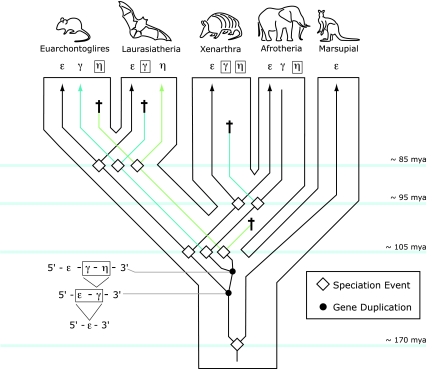Fig. 4.
A model describing the evolution of the β-globin gene family in eutherian mammals. According to this model, two successive duplications of a proto-HBE gene gave rise to the HBG and HBH genes in the ancestor of eutherian mammals after divergence from marsupials. Consequently, the full complement of embryonic globin genes—HBE-HBG-HBH—was present in the common ancestor of the two main clades of eutherian mammals, Boreoeutheria (comprising Euarchontoglires and Laurasiatheria) and Atlantogenata (comprising Xenarthra and Afrotheria). Subsequent to the Boreoeutheria–Atlantogenata split (≈105 Mya), the HBH gene was deleted in the common ancestor of xenarthrans and afrotherians, and the HBG gene was lost in xenarthrans after divergence from the afrotherian lineage (≈95 Mya). The ancestral three-gene set was also present in the common ancestor of Euarchontoglires and Laurasiatheria. Subsequent to the divergence of these two groups (≈85 Mya), the HBG gene was lost in laurasiatherians and the HBH gene was lost in Euarchontoglires. Latin crosses denote lineage-specific gene losses, either via deletion or inactivation.

